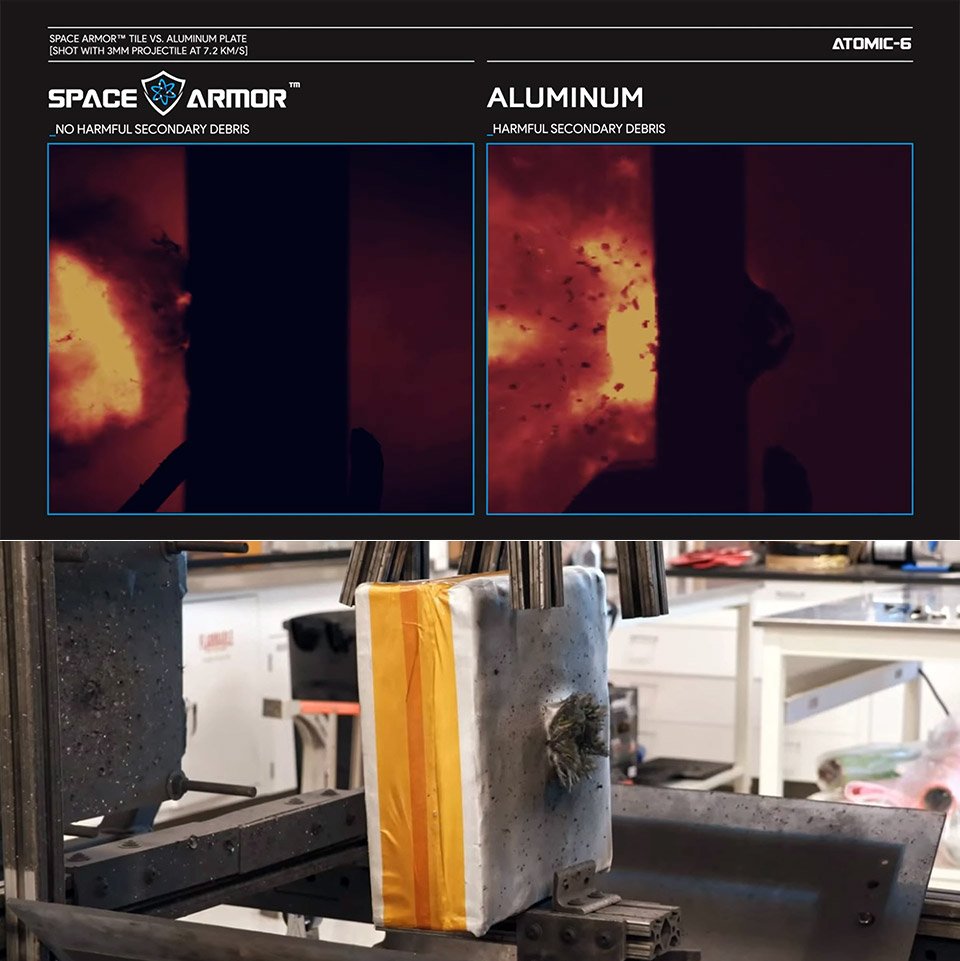More than 130 million pieces of space junk – from old rockets to exploded payloads – zoom around Earth at over 7 kilometers per second. A single paint chip coming from the other direction can punch a hole in a spacecraft’s hull or an astronaut’s suit. For decades, engineers have used the same old solution: a metal barrier born in the 1940s. Now a small company in Georgia is rewriting the rules with something deceptively simple – a tile, called Space Armor, that sticks on like a giant Post-it, yet stops disasters before they happen.
Atomic-6, tucked away in Marietta, calls their creation Space Armor. These aren’t big metal plates bolted on during frantic assembly lines. Instead the tiles are a foot square and an inch thick, made from a custom blend of fibers and resins pressed together in a process the company keeps secret. Self-adhesive backs mean no rivets or welds; just peel, stick and launch. Custom orders go up to a meter across for bigger surfaces. Over 18 months the team honed this down, working on contracts with the U.S. Space Force to achieve a goal that sounds simple but has stumped experts for years: build a shield that works without weighing down the mission or silencing the very antennas it’s supposed to protect.

LEGO Icons Shuttle Carrier Aircraft Building Set for Adults – Spaceship & Airplane Model Kit for Adults,…
- 2 AVIATION LEGENDS, 1 BUILD – Recreate the iconic Boeing 747 and NASA Space Shuttle Enterprise with the LEGO Icons Shuttle Carrier Aircraft (10360)…
- DEPLOY LANDING GEAR – Turn the dial to extend the massive 18-wheel landing system on your airplane model, just like real flight operations
- AUTHENTIC FEATURES & DETAILS – Remove the tail cone, engines, and landing gear from the NASA shuttle and stow them in the cargo bay during flight
In 1942, astronomer Fred Whipple drew his namesake shield on paper, envisioning spaced sheets of aluminum to break apart incoming threats. It saved Apollo crews from cosmic dust and variants still wrap modern satellites. But aluminum has flaws that show up in the cold vacuum. When hit, it shatters into fresh shrapnel – worse than the original bullet. Those layers also trap radio waves like a metal box, forcing designers to choose between armor and chatter with ground control. Whipple’s setup demands factory precision, adds pounds that eat into fuel budgets and costs a fortune in materials and labor. Space Armor sidesteps all of that.
Engineers at Atomic-6 blasted aluminum projectiles at their tiles in labs at the University of Dayton and Texas A&M – pushing speeds way beyond what’s normal in space flight. And the results are pretty impressive: their tiles can withstand hits from objects that are over 12.5 millimeters wide, taking the impact without so much as a small bit of damage flying off elsewhere. One test in particular, pitted a tile made out of Space Armor against one made of just metal – the metal just exploded in a shower of fragments much bigger than the one that hit it, while the Space Armor tile absorbed the hit and kept on ticking. Not a single fragment flung off, just a solid thud – and your spacecraft stays intact. At the kind of speeds where even a tiny speck of paint is like a hand grenade, that is some seriously reassuring stuff. That containment can mean the difference between disaster and a minor blip in the logs.
Space Armor Lite is the answer to the everyday problem of tiny debris – the sort of thing that’s around 3 millimeters across and makes up more than 90 percent of low Earth orbit threats – all the small stuff just a bit bigger than a centimeter. This version of the system is 30% lighter and 15% thinner than like systems, freeing up room for more solar panels or instruments to be added in. If you’re going to be flying through a crowded field of debris or near a crewed station, Space Armor Max is the way to go – it’s rated to withstand those 12.5mm bruisers. They come in hexagonal shapes so you can get a seamless cover, and here’s the real bonus – they don’t block radio signals, so you can keep on transmitting and your electronics keep on humming. Atomic-6 even does a version that will block signals if that’s what you need, but the ones that leave signals clear open up all sorts of possibilities for radomes – domes that can shield your dishes without cutting you off from the conversation.
[Source]
